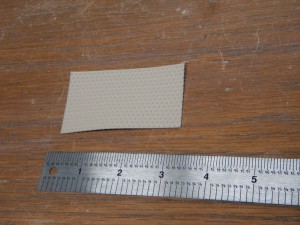I have been looking for some good material to use as a floor covering. Bob uses bare aluminum, and that method certainly has some merits. It is light, simple, and durable. Tabitha would rather have something that looks a bit more finished, but also something that dampens vibration a little bit better. She says that prolonged exposure of her feet to a vibrating structure like the floor will accelerate the development of arthritis and contribute to an overall mood of malaise and discontent.
I don’t really want to use something like carpet, because I know that it is going to be harder to clean than a solid surface. I don’t want to have to worry about getting into the airplane with slightly dirty shoes. I’d really like to find the airplane equivalent of linoleum, and there is a great example of it on the floor of our planes at work. It is thin, easy to clean, and super durable. It gets the foot traffic of lots of people, every other hour or so, every day, all day, and lasts years under those conditions. I asked a few of the mechanics about where it comes from, but they don’t know. Even if I could find who makes it, chances are good that it would not be available in the small quanitity and price that I would like to have.
A similar product is available for household floors, but it is 1/8″ thick and extremely heavy (pounds per square foot).
One of the email list members suggested that I try products intended for boat floors. This was a good lead, and soon I found Nautolux Decco Dot flooring. It has all of the good qualities that I like, and it is very light weight. I think that the entire floor would be under 5 pounds, perhaps even less. The bad news about the Nautolux is that it is a little bit too thin, such that it needs to be glued down to stay flat. It also doesn’t have much in the way of vibration dampening. I ordered a sample piece to try some burn testing on.
The whole idea of burn testing is a little bit silly in some ways. At first it seems like a really good idea to make sure that the interior materials have good qualities with regard to flamability. The unfortunate reality is that since the rest of the interior is made of aircraft fabric, the huge wall sections are certainly the weakest link. Having said that, I’m planning to burn a small piece of each proposed interior material, just to see if it is at least acceptable. Burn tests aren’t legally required for experimental airplanes of course.
Since the Nautolux is so thin, I figured that I could try to find some 1/8″ closed cell foam to use between it and the floor. This would help dampen vibration and noise, and also not add too much weight.

I took the above piece and stuck it in the propane heater for an unscientific test. It started to burn, and when I took it away from the heater, the flame died down. That’s convincing enough for me, since it didn’t continue to burn brighter.